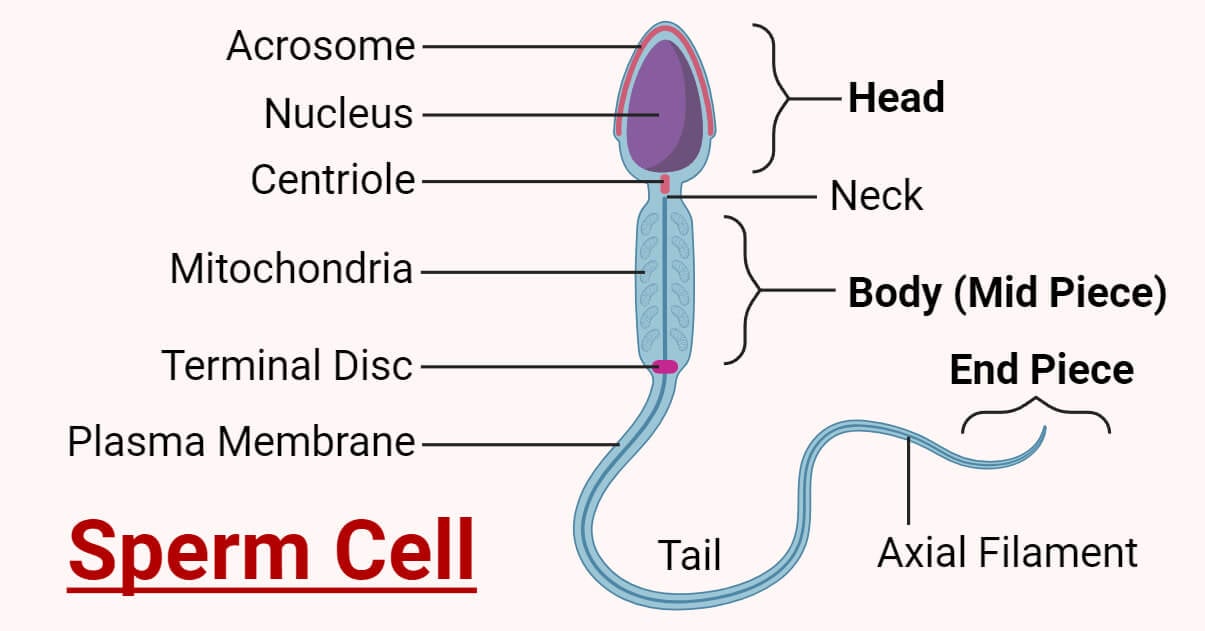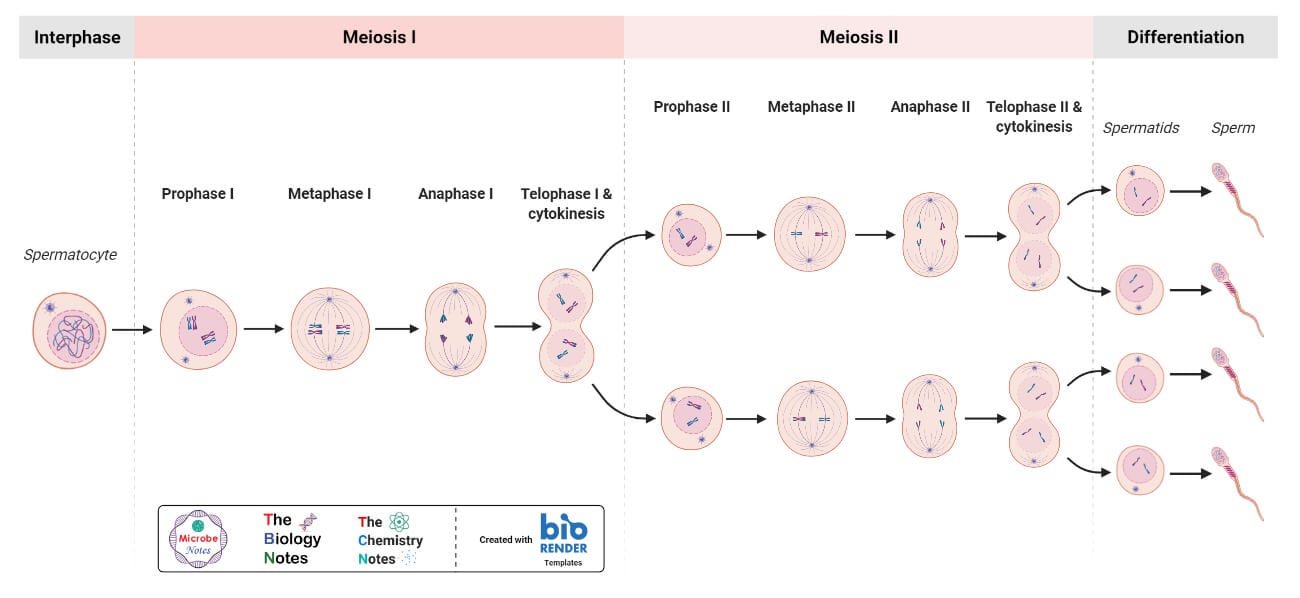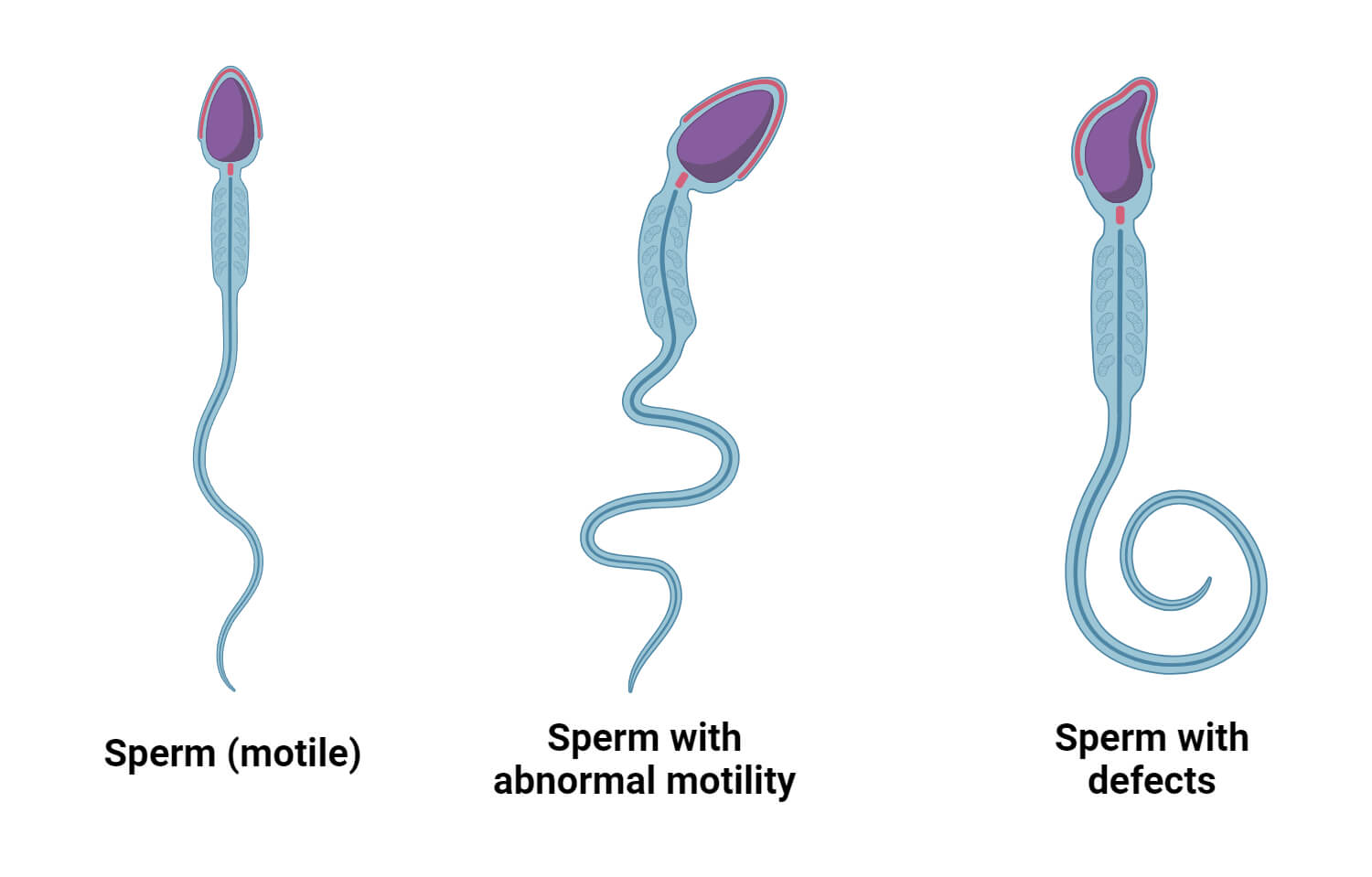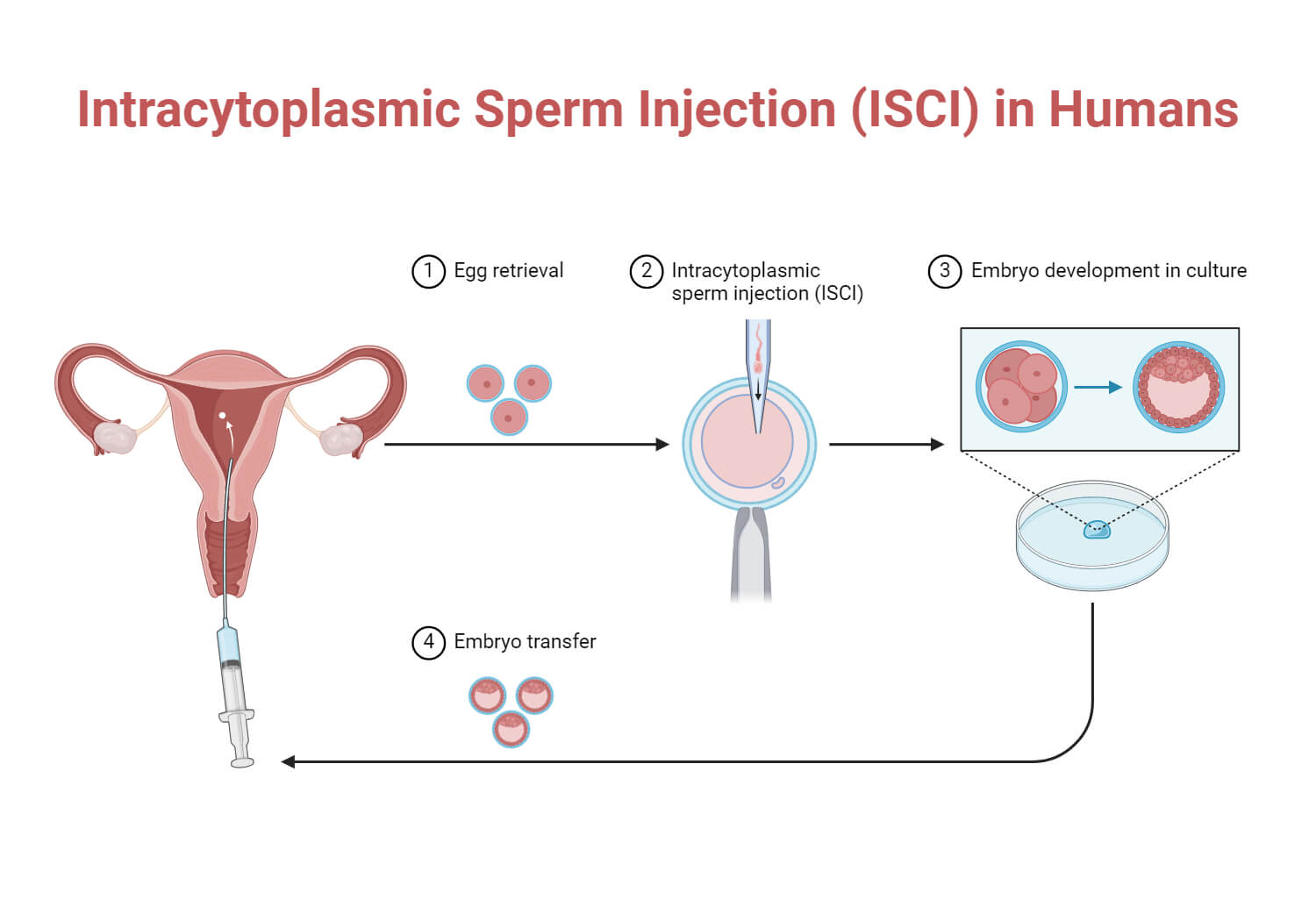The sperm cell, also known as the spermatozoon, is the male reproductive cell produced from the male reproductive organ. It unites with the female egg cell to produce a diploid zygote.
The sperm cells are formed through the process of spermatogenesis in the seminiferous tubules of the testes. Once matured, sperm cells are released into the epididymis, where they gain motility and become ready for fertilization.
Like the egg cells, sperm cells are also haploid containing only half the number of chromosomes and the fusion of these cells forms a diploid organism.
Interesting Science Videos
Anatomy and Structure of Sperm Cell
The sperm cell is a microscopic and flagellated motile cell with a unique structure that is made up of a head, a midpiece, and a tail. The whole body of sperm is covered by a layer of the plasma membrane.

The three main parts of sperm are:
- Head: The head region is usually a flat pear-shaped structure with a pointed tip and a broad base that contains the genetic material of the sperm cell within the cell nucleus. It is covered by a cap-like structure called acrosome which contains hydrolytic enzymes essential for penetrating the layers of the egg during fertilization. This process is called the acrosome reaction. The human sperm cell nucleus is haploid meaning it contains only 23 chromosomes. When this haploid cell fertilizes with the ovum, it produces a diploid zygote containing 46 chromosomes.
- Body: The body, also called the midpiece, is the middle portion of the sperm cell that contains mitochondria. This region is essential for providing the energy required for the movement of the cell.
- Tail: The tail or flagellum of the sperm makes up about 80% of its entire length. The tail gives the sperm cell movement. It contains the axoneme which is a bundle of microtubules surrounded by mitochondria. In the axoneme, there are two central singlet microtubules surrounded by nine microtubule doublets. The movement of the flagellum is powered by dynein motor proteins which use the energy from ATP hydrolysis produced by mitochondria in the midpiece.
What is Spermatogenesis?
Spermatogenesis is the process of formation of sperm cells in the testes. The testes are the male reproductive organs producing sperm and testosterone. They contain tightly coiled structures called seminiferous tubules within which the sperm cells are produced. There are specialized cells scattered among these tubules called Sertoli cells, which provide nutrients to the developing sperm cells.
- The process of spermatogenesis starts with spermatogonia which are immature cells derived from stem cells called primordial germ cells in the outer wall of the seminiferous tubules. These stem cells migrate into the testis during early embryogenesis and proliferate continuously by mitosis. Half of the resulting cells remain as stem cells, while the others stop proliferating and proceed to become future sperm cells.
- The cells that mature into sperm cells differentiate into primary spermatocytes. These primary sperm cells migrate towards the Sertoli cells where they further develop. Then, the primary spermatocytes undergo meiotic division I to form secondary spermatocytes. While the nucleus of primary sperm cells contains 46 chromosomes, secondary sperm cells contain only 23 chromosomes, similar to the egg. The secondary spermatocytes further proceed through meiotic division II to produce haploid spermatids.
- The haploid spermatids mature and differentiate into mature sperm cells called spermatozoa through the process of spermiogenesis. This maturation process involves specific changes in the structure of the sperm cell. The nucleus assumes an oval shape forming the head of the sperm. At the opposite end of the head is the tail which originates from the cytoplasm of the secondary sperm cell. After fully matured, the sperm is stored within the epididymis of the testes.

Functions of the Sperm Cells
- The main function of sperm cells is to fertilize the female egg cell to form a new individual. The fusion of a sperm cell with an egg forms a zygote which undergoes cell division to form an embryo.
- The sperm cell contributes a haploid set of chromosomes to its offspring. This genetic material determines the genetic traits and characteristics of the offspring.
- Sperm cells are highly specialized for motility and contain a flagellum that allows them to swim through the female reproductive tract. This movement is needed to reach the egg within the fallopian tube for fertilization.
- Sperm cells have specialized structures and enzymes within the acrosome which covers the head of the sperm. The acrosome contains enzymes that help in penetrating the protective layers of the egg. Once the sperm reaches the egg, these enzymes are released in a process called the acrosome reaction.

Diseases and Disorders of Sperm Cell
- Azoospermia is one of the main causes of male infertility. It is a disorder that occurs due to the absence of sperm in the ejaculate. The causes of azoospermia may include blockages in the reproductive tract, hormonal imbalances, or certain genetic conditions. Diagnostic tools for azoospermia include hormonal tests, semen biomarkers, ultrasonography, testicular biopsy, and vasography. Treatment options for azoospermia include surgery, hormonal therapy, and sperm retrieval using assisted reproductive technologies like in vitro fertilization (IVF).

- Oligozoospermia is a condition that occurs due to a low sperm count, where the number of sperm is below the normal range. Oligozoospermia can impact fertility. Various factors can contribute to oligospermia, including genetic disorders like Klinefelter syndrome, infections, hormonal abnormalities, blockages in the reproductive tract, exposure to toxins, and certain medications. Diagnostic tests may include semen analysis, sperm function tests, imaging tests, hormone level measurements, and genetic testing.
- Asthenozoospermia is a condition that occurs due to reduced sperm motility. Sperm motility is important for reaching and penetrating the egg during fertilization. Sperm with reduced motility have difficulty reaching and fertilizing the egg. This can reduce the chances of successful fertilization.
- Teratozoospermia is characterized by abnormal sperm morphology. Abnormal sperm morphology may cause difficulty in penetrating the barriers of the egg for fertilization. This condition also reduces the chances of successful fertilization.
- Testicular cancer is the abnormal growth of cells in the testes. These cancerous cells tend to grow rapidly, spreading to other body parts. Most of the testicular cancer begins in the germ cells in the testes. The causes of testicular cancer are not clearly understood. It usually begins when certain factors change the DNA of cells in the testes, causing them to grow and multiply abnormally. Diagnosis of testicular cancer includes several tests and procedures including physical examination, ultrasound, serum tumor marker test, and other imaging tests. Treatment options commonly involve surgical intervention, radiation therapy, and chemotherapy.
- Varicocele is a condition that occurs due to swelling of the veins within the scrotum that drain blood from the testicle. Varicocele causes low sperm count, reduced sperm motility, and abnormal sperm morphology. These issues can significantly affect fertility. They can also affect testicular growth and function. Surgery of varicocele improves sperm motility and morphology.
- Infections of the reproductive system such as epididymitis and some sexually transmitted infections can also affect sperm production. These infections can block the passage of sperm.
References
- Alberts B, Johnson A, Lewis J, et al. Molecular Biology of the Cell. 4th edition. New York: Garland Science; 2002. Sperm. Available from: https://www.ncbi.nlm.nih.gov/books/NBK26914/
- Britannica, T. Editors of Encyclopaedia (2024, April 4). spermatogenesis. Encyclopedia Britannica. https://www.britannica.com/science/spermatogenesis
- Britannica, T. Editors of Encyclopaedia (2024, February 10). sperm. Encyclopedia Britannica. https://www.britannica.com/science/sperm
- Gilbert SF. Developmental Biology. 6th edition. Sunderland (MA): Sinauer Associates; 2000. Spermatogenesis. Available from: https://www.ncbi.nlm.nih.gov/books/NBK10095/
- List of Sperm Disorders that Cause Male Infertility (invitra.com)
- Male infertility – Symptoms and causes – Mayo Clinic
- Oligospermia (Low Sperm Count): Causes & Treatment (clevelandclinic.org)
- Sharma M, Leslie SW. Azoospermia. [Updated 2023 Nov 18]. In: StatPearls [Internet]. Treasure Island (FL): StatPearls Publishing; 2024 Jan-. Available from: https://www.ncbi.nlm.nih.gov/books/NBK578191/
- Sperm Cell | Importance, Structure, Summary GCSE Biology (alevelbiology.co.uk)
- Spermatozoa: Anatomy and function | Kenhub
- Suede SH, Malik A, Sapra A. Histology, Spermatogenesis. [Updated 2023 Mar 6]. In: StatPearls [Internet]. Treasure Island (FL): StatPearls Publishing; 2024 Jan-. Available from: https://www.ncbi.nlm.nih.gov/books/NBK553142/
- Testicular Cancer: Symptoms, Signs, Causes & Treatment (clevelandclinic.org)

crackhead